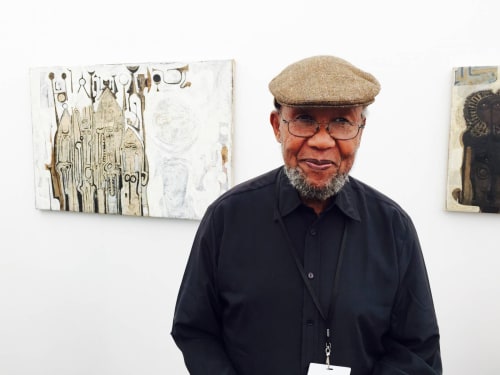Sudanese, Oxford-based artist Ibrahim El-Salahi was the first African artist to have a retrospective at the Tate Modern. That was in 2013, when the artist was 83 years old. Born in Omdurman, Sudan, he studied at the Slade School of Art in London before returning to Khartoum to continue his practice and teach, where he was one of the founders of the modernist movement, the Khartoum School.
His paintings and drawings are influenced by his African and Arab culture, and are filled with a spirituality that has remained in his work over the decades. Last fall, El-Salahi exhibited Meditation Tree, his first 3-D piece ever. The sculpture grew out of his “Tree” series, which explored the beauty of the Haraz tree, which is indigenous to Sudan. His work has been a means for meditation, such as when he was wrongly imprisoned without trial in Sudan for over six months, and, more recently, as a way to cope with chronic pain.
El-Salahi has been dealing with his physical discomfort through a new body of work, “Pain Relief.” He has found solace in drawing on discarded medicine packets, calming his mind through drawing.
The artist shared with Whitewall how art is meant to serve not only the maker, but the community, and humanity at large.
WHITEWALL: What is a typical day in your studio like?
IBRAHIM EL-SALAHI: I start by keeping calm, thinking about what I want to do, what I am sure of. I like to be quiet and not to be disturbed by telephone calls or anything at all. That’s how I start in the studio and that’s the kind of atmosphere I like to have.
WW: You’ve been working on a recent series, “Pain Relief.” Tell us how that work began.
IES: Well, it began with pain, because I suffer from back pain and sciatica and I had plenty of painkillers, which I never liked at all, but I had to take them because of the pain. I found that I’m tied to my bedroom and a comfortable armchair, and that helps me to reduce the pain a little bit. I am surrounded by packets of medicine, so I said, “What a waste. Why don’t I use them?”
I started opening them and chopping them to size, and I started working on them. I had a number of pens with waterproof and fade-proof ink, which the material of those kinds of packages takes very nicely. So I started working on them. They are a very small size. It reminds me of the time when I found paper in prison and did sort of little images as the nucleus. So I pray and bring peace and calm in my mind that I use as imagery, that can be transmitted to other people when they see my work in exhibitions, and so on. That’s how I work.
WW: You said that these drawings are a form of meditation for you. Have you always seen your work that way?
IES: Yes, I did, I did. I think of it as, “This is what I am capable of doing and which I am to do—to create and to give to other people.”
WW: Do you think art or artmaking can be a form of medicine?
IES: Very much indeed. I think with concentration, and looking into the work itself and how it is, it helps me. And if it helped me, it might help other people as well.
WW: What kind of reactions to these recent works have you seen?
IES: The “Pain Relief” works have only been shown once, at the Ashmolean Museum, and I’m glad to say, I think they caught people’s eyes.
WW: Why are you doing the big monoprints?
IES: Because with the small drawings I did on the packages and paper, it is an artwork by itself, but at the same time, when it is enlarged, it works very well indeed. The gallery understood the idea, which I always thought of—blowing them up to expand. That was the same idea that I had in the beginning, the idea of an organic growth of a picture. It has a great potential of moving from a small size to a large size.
The work is alive and it has a kind of potential of its own. Once you put it there and you give it all that you have, then it works fine.
WW: How do you think this series relates in a way to other work?
IES: Well, that is the nucleus. The idea of the nucleus, like the seed, if you have water and enough sunlight, it can grow into a larger size. It’s the origin; that’s the main thing.
WW: You’ve said that your work serves three people: the self, the family and community, and all humans.
Is that something you think about when you are painting?
IES: Yes, very much indeed. I never believe art as art for art’s sake, just to do in the studio for the artist’s society only. I’m thinking about the work itself. I’ve had a great deal of help from people around me—from family, from children, from people in my own culture, and so on. And at the same time, it’s about human beings all over the world.
I find that artwork is never completed unless the others have an idea about it. That’s why I try never to give titles. Though sometimes some of them tell me they have a name. It’s a communal thing, something which grows with the contribution given to it by others. So it’s something made for me, for others, and for all. I always think this is how work should be, as far as I myself am concerned.
Ibrahim El Salahi’s “Pain Relief” will be on view with Vigo Gallery at Salon, Saatchi Gallery this June and July.


